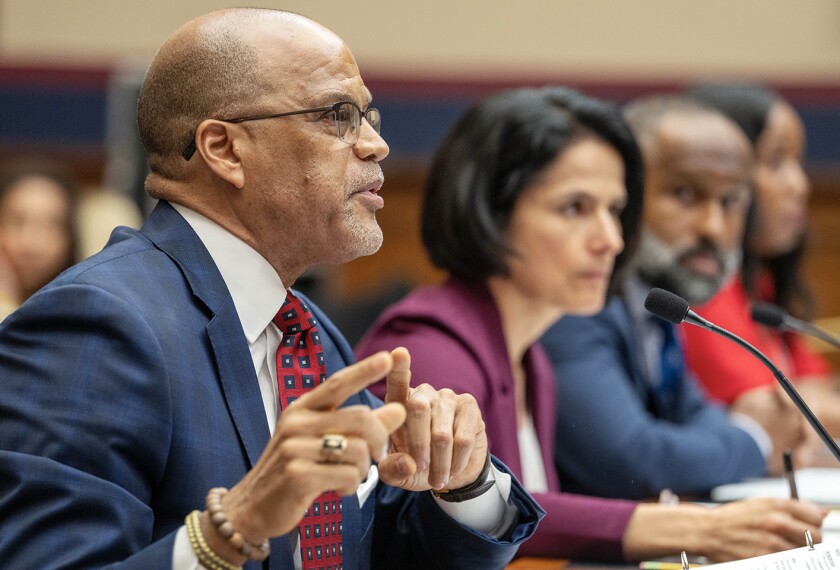The causes of events are ever more interesting than the events themselves. —Marcus Tullius Cicero (106-43 B.C.), Roman writer, politician, and orator
As a society, we seem so caught up in the moment, so linked electronically to real-time events around the world, that we have little capacity for knowing and appreciating history.
But we ignore the past at our peril. This is particularly true for political issues, including education. It is important to learn, as Cicero so wisely wrote, about the people and events that have led us to the present.

Looking to history, you can find a context for virtually any K-12 policy discussion going forward. Consider Ronald Reagan’s support of academic standards in the 1980s and George H.W. Bush’s convening of the nation’s governors around education in 1989: What insights can these moments offer on reaching agreement around higher standards? It’s interesting to note that many Reagan acolytes today vigorously condemn nationally determined higher standards.
Here are some other intriguing bits of information:
• In 1949, a verbal food fight erupted between former first lady Eleanor Roosevelt and Cardinal Francis Spellman, the Roman Catholic archbishop of New York, over whether to allow federal funding to go to nonpublic schools. It wasn’t until 1965 and the passage of the Elementary and Secondary Education Act that the “child-benefit theory” was put forth, allowing federal dollars to support certain activities for poor children as long as the funding wasn’t in the control of a church or church school and was used only for educational purposes.
• In 1956, the National Education Association, along with several other labor organizations, opposed a legislative amendment in the U.S. House that would have required that federal construction aid go only to desegregated school districts.
Observers look back at the historic national education summit in Charlottesville, Va., in 1989.
• In 1965, Sen. Robert F. Kennedy, D-N.Y., became the first political leader to ask how to determine if Title I helped low-income students. The question remained unaddressed until passage of the 1988 amendments to the ESEA.
• In 1971, the then-U.S. Office of Education was able to act on grant applications for the Emergency Aid program within 48 hours. The quick federal response undercut arguments from segregated school districts that they couldn’t find the money to dismantle their existing programs, and it played a significant role in dismantling dual school systems in the South.
• The federal government promised in 1975 that it would provide up to 40 percent of the cost of special education for children with disabilities. The promise, made with no basis in research and to this day unfulfilled, today lives on as something of a policy legend.
• The murder of U.S. Rep. Leo J. Ryan, D-Calif., in one of the incidents surrounding the 1978 “Jonestown massacre” in Guyana, proved a significant and tragic turning point in the creation of the U.S. Department of Education. Ryan had led Democrats opposing the agency; after his death, that opposition collapsed, and legislation establishing the department passed by a narrow margin.
There is a strong movement, driven by forces on the left and the right, to turn back the clock."
The congressional debates of the late 1970s over the department’s start, now largely forgotten, foreshadowed conflicts over the agency’s agenda today. What can the history of those debates, which included a vote to bar the adoption of any federal curriculum, tell us about a current war of words over the federal role in the adoption of the Common Core State Standards?
With the retirement this year of both Sen. Tom Harkin, D-Iowa, the chairman of the Senate education committee; and Rep. George Miller of California, the top Democrat on the House education panel, our institutional memory of federal K-12 policy will be greatly diminished when the 115th Congress convenes in January.
While there is a logical argument to make that this void will free people from defending the past, it also may mean that, without an understanding of history, we will be condemned to repeat its failures. In my book Political Education: Charting the Course for State and Federal Policy, I consider how issues such as national defense, civil rights, the War on Poverty, and states’ rights, as well as personalities such as the Kennedy brothers, Bill Clinton, and Ronald Reagan have shaped federal policy. Each person, each issue, has made important contributions that affect us today.
There is a strong movement, driven by forces on the left and the right, to turn back the clock to earlier times, when the federal presence was minimal. But doing that without addressing what we have learned about state capacity, the value of external monitoring, or the role played by functions like data collection and research at the federal level could create confusion and turmoil.
Similarly, it would be foolish not to recognize that, with 50 states and over 13,000 school districts, federally devised solutions are often just not practical nor implementable and would further alienate the teachers and leaders who have the daily responsibility to educate our children. States are in the middle, responsible to voters, parents, students, and the federal government.
A variety of indicators, ranging from the analysis of state data and college-entrance and -completion rates to international comparisons vividly portray the state of education in the nation, and the picture that emerges is not bright. While we invest hundreds of billions of dollars in education, it is less than clear that our young people are getting the excellence they deserve.
Not having had a reauthorization of the Elementary and Secondary Education Act since President George W. Bush signed the No Child Left Behind Act in 2002, we know there is much work to be done. As we prepare to tackle new policies and legislation, time spent learning history is time well spent.




